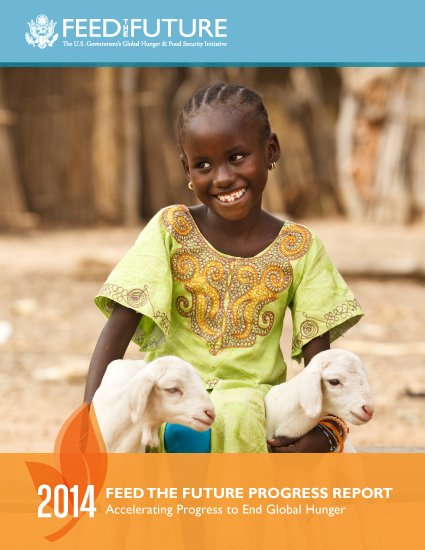For Immediate Release
WASHINGTON, D.C. – U.S. Agency for International Development (USAID) Administrator Rajiv Shah announced today that President Obama’s Feed the Future initiative has reached nearly 7 million smallholder farmers and helped to save 12.5 million children from the threat of hunger, poverty, and malnutrition in just the last year alone. Since it was formed four years ago, Feed the Future and complementary efforts have attracted billions of dollars in investments focused in agriculture, introduced affordable new technologies aimed at increasing agricultural production and managing the risks of a changing climate, and introduced nutrient-packed foods to millions of mothers and children around the world.
Feed The Future 2014 Progress Report ![]() (pdf - 12.6MB)
(pdf - 12.6MB)
“Feed the Future has hit its stride, delivering results that are changing the face of poverty and hunger for some of the world’s poorest families,” said Administrator Shah. “Working alongside thousands of partners from the private sector, civil society, and local leaders, we are pioneering a new model of development—one grounded in country leadership, policy reforms, cutting-edge measurement and evidence, and a relentless focus on delivering real results.”
Currently, Feed the Future works in 19 focus countries in Africa, Asia and Latin America and the Caribbean. Overall in 2013, the initiative helped nearly 7 million farmers and food producers use new technologies and management practices—such as high-yielding seed varieties—on about 9.9 million acres of land, an area greater than the states of Massachusetts and New Jersey combined. It has reached more than 12.5 million children with nutrition interventions that can help ensure a stronger and more successful future.
Feed the Future and its complementary efforts, such as Grow Africa and the New Alliance for Food Security and Nutrition, have helped to leverage billions of dollars in private sector commitments in African agriculture. In African countries alone, Obama Administration anti- hunger and poverty efforts have helped to reach 2.6 million farmers and gathered $7 billion in private sector commitments to African agriculture.
Here are some examples of how Feed the Future is working:
- In Bangladesh, reached 3.3 million smallholder farmers with improved seed, fertilizer and farm management practices, helping farmers increase rice yields by up to 20% and creating additional rice sales of $25 million.
- In Senegal, helped farmers produce enough rice to meet the consumption needs of more than 400,000 Senegalese for one year.
- In Honduras, moved more than 4,300 families well above the $1.25-per-day poverty line in part by increasing horticulture sales by 125%.
- Ethiopian company Guts Agro Industry developed a ready-to-use supplementary food made with specialty chickpeas sourced from 10,000 smallholder farmers, with plans to expand to 52,000 smallholders.
The 2014 Feed the Future Progress Report was released today during the Feed the Future Global Forum, an event bringing together stakeholders and partners from around the world to highlight progress, address challenges and chart a way forward in the fight against hunger and poverty. The report outlines how Feed the Future is working to scale-up proven technologies and activities, expand nutrition interventions and programs, and conduct research to create the next generation of innovations that can change the lives of food producers and their families. The full 2014 Feed the Future Progress Report can be found online at http://www.feedthefuture.gov/
USAID is the lead U.S. Government agency that partners to end extreme poverty and promote resilient, democratic societies while advancing security and prosperity in the United States and around the world.








Comment
Make a general inquiry or suggest an improvement.